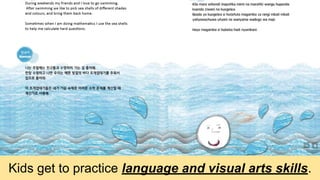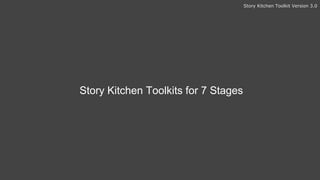About Storycookers & Storypals
- 1. I. Storycookers - Question ŌĆ£What can we do to help children unlearn prejudice and preconceptions and thus become free to imagine? At the same time, what can we do to empower them with core abilities required for higher education, careers, happiness and meaningful life?ŌĆØ by Storycookers
- 2. Understand & Design Characters and Perspectives
- 3. Globally Collaborate in Intercultural Storytelling
- 4. Influence the World with Your Message
- 5. II. Storycookers Vision Mission Trustworthy education engineering company that inspires authentic growth and happiness in all stakeholders which empowers the company to revolutionize global competency education for preteens. Philosophy All components of educational engineering at Storycookers must create educational environment that support our program users to build growth competency and apply them to global competency. Enhance global competency of preteens by using intercultural storytelling as ameans of collaboration for advancing values that have personal, local, and global significance.
- 6. III. Storypals Program Manual for Teacher-Mentors Presented by Storycookers
- 7. STORYPALS 7 Process Storypals Toolkit Version 3.0
- 8. Time for preparing my story journey. Stage 1 - Stage 2 - Stage 3 - Stage 4 - Stage 5 - Stage 6 - Stage 7 Introduction of Authors Story Kitchen Toolkit Version 3.0
- 9. Stage 1 - Stage 2 - Stage 3 - Stage 4 - Stage 5 - Stage 6 - Stage 7 Team Building Time for preparing our story journey. Story Kitchen Toolkit Version 3.0
- 10. Stage 1 - Stage 2 - Stage 3 - Stage 4 - Stage 5 - Stage 6 - Stage 7 Time to create our unique character. Storypals Characters Story Kitchen Toolkit Version 3.0
- 11. Stage 1 - Stage 2 - Stage 3 - Stage 4 - Stage 5 - Stage 6 - Stage 7 Story Recipes Time to practice creating a story by inviting other storypal characters. Once upon a time, ... Everyday, ŌĆ” One day, ŌĆ” Because of that, ŌĆ” Because of that, ... Until finally, ... Story Kitchen Toolkit Version 3.0
- 12. Stage 1 - Stage 2 - Stage 3 - Stage 4 - Stage 5 - Stage 6 - Stage 7 Creating Our Story Time to pick our favorite story recipe(s) and create our final story. Story Kitchen Toolkit Version 3.0
- 13. Stage 1 - Stage 2 - Stage 3 - Stage 4 - Stage 5 - Stage 6 - Stage 7 Time to reflect on our achievements, lessons learned, and feelings. Epilogue Story Kitchen Toolkit Version 3.0
- 14. Stage 1 - Stage 2 - Stage 3 - Stage 4 - Stage 5 - Stage 6 - Stage 7 Time to publish our story to be shared with families and friends. Publishing Story Kitchen Toolkit Version 3.0
- 15. Storypals Toolkits for 7 Stages Storypals Toolkit Version 3.0
- 16. Stage 1. Introduction of Authors I am... 1-1. Introduce yourself 1-2. Take an author profile photo (You can choose to substitute the photo with a self-portrait.) Storypals Toolkit Version 3.0
- 17. Our Ideas for Successful Collaboration 1. 2. 3. 2-1. Brainstorm your ideas for successful collaboration Storypals Toolkit Version 3.0 Stage 2. Team Building
- 18. Ļ░ł ļō▒ ņ╣┤ ļō£ 1. Each person in the class write a probabl conflict situation on a card. 2. Collect all cards and mix the cards. 3. Each person pick a card. 4. Gather in teams and test collaboration strategies. 5. Make a short class presentation about your findings. Conflic Cards 2-2. Test your ideas for successful collaboration Storypals Toolkit Version 3.0 Stage 2. Team Building
- 19. Stage 2. Team Building 2-3. Select your know-how for successful collaboration Our Know-how for Successful Collaboration 1. 2. 3. Storypals Toolkit Version 3.0
- 20. [Food] [School] [Sports] [Space] 3-1. Pick a topic card (or come up with a new topic card) Storypals Toolkit Version 3.0 Stage 4. Story Recipes
- 21. [Food] Bulgogi Korean styled pizza. Kimchi Sea food jeon dessert red-bean sherbet rice cake rice Bibimbob injeolm i Shinsoll o Topic Stage 3. Storypals Characters 3-2. Expand your ideas on your topic Storypals Toolkit Version 3.0
- 22. A: Character Keyword Bibimbob B: Character Personality Background Topic spoon vegetabl e Chili material Character keyword Chili hot Character keyword spicy joyful red passi onate Stage 3. Storypals Characters 3-3. Focus your ideas Storypals Toolkit Version 3.0
- 23. Stage 3. Storypals Characters 3-4. Sketch your character Storypals Toolkit Version 3.0
- 24. Stage 3. Storypals Characters 3-5. Color your character Character Profiling Name: Age: Place of Birth: Personality: Special Aspects: Recent Worries or Curiosity: Dream or Wish: 3-6. Create a profile Storypals Toolkit Version 3.0
- 25. Storypals Toolkit Version 3.0 Stage 4. Story Recipes
- 26. 4-1. Pick (a) storypal character(s) created by other authors Storypals Toolkit Version 3.0 Stage 4. Story Recipes
- 27. 4-2. Experiment by creating various story recipes Once upon a time, ... Everyday, ŌĆ” One day, ŌĆ” Because of that, ŌĆ” Because of that, ŌĆ” Until finally, ... Storypals Toolkit Version 3.0 Stage 4. Story Recipes
- 28. 5-1. Free Discussion 1) Preparation: - Select a team meber to be responsible of writing down discussion contents. - Have empty papers, pens, and post-it papers ready. 2) Set a time limit and have each member write down ideas for the story on post-it papers. There should be ONE idea writen down for ONE post-it. 3) When time is up, spread the post-it memos on a table or on a wall and group similar ideas together. 4) Discuss ideas for bridging the different set of ideas. 5) Take turns and speak out loud one sentence to create a story draft. The team member in charge of writing down the discussion contents should write down the ideas. Storypals Toolkit Version 3.0 Stage 5. Creating our Story
- 29. 5-2. Storyboard Discussion : LetŌĆÖs link story draft with illustrations. 1) Find used papers and prepare storyboards by numbering the papers. You choose between horizontal or vertical use of the storybaords. 2) Spread the storybaords on a table or a wall to discuss ideas. On one side, you can sketch corresponding illustrations for your story. On the other side, you can write corresponding texts for your story. Storypals Toolkit Version 3.0 Stage 5. Creating our Story
- 30. 5-3. Minibook Test 1) Make a minibook 2) Get feedbacks from friends outside your team, family members and teachers. You can sketch your illustraion on the top. You can write your story on the bottom. Storypals Toolkit Version 3.0 Stage 5. Creating our Story
- 31. 5-4. Finalizing our Story : Incorporate feedbacks to start finalizing your story. Storypals Toolkit Version 3.0 Stage 5. Creating our Story
- 32. 5-5. Edit and Improve : Continue to edit your story by checking grammars, spellings and contexts while improving the quality of illustrations. Upgrade! Upgrade! Upgrade! Stage 5. Creating our Story Storypals Toolkit Version 3.0
- 33. Stage 6. Epilogue Film message from the authors (About 3 minutes in total) 1) Greet your audience and riefly introduce team members 2) Briefly introduce storypal characters in the story 3) Share the main message that you want the audience to know 4) Thank and say goodbye to the audience 6-1. Message from the authors Storypals Toolkit Version 3.0
- 34. Stage 6. Epilogue 6-2. Write a Team Epilogue Throughout this project, weŌĆ” Storypals Toolkit Version 3.0
- 35. Stage 7. Publishing* (*In some cases, this stage may be done by Story Mentor or other supporters.) 7-1. Compile Image Files ŌŚÅ Scanned illustrations and photos 7-2. Compile Text Files ŌŚÅ Typed author profile, story and epilogue 3. Share everything with your Story Mentor Storypals Toolkit Version 3.0
Editor's Notes
- ņäĀņāØļŗś, ĒöäļĪ£ĻĘĖļש ņśłņŗ£ ļ¦īļōżĻĖ░ņŚÉ ņ░ĖņŚ¼ĒĢ┤ļ│┤ņäĖņÜö. ĻĘĖļ”¼Ļ│Ā ļŗ╣ņŗĀņØś ĒöäļĪ£ĻĘĖļשņśłņŗ£ļź╝ ļ¬©ļōĀ ņäĀņāØļŗśļōżņŚÉĻ▓ī Ļ│Ąņ£ĀĒĢ┤ļ│┤ņäĖņÜö.
- Please explain the five promises to the students refering to the basic guide as follows: 1. Respect: Treat others as you want to be treated. 2. Focus: Always remind youself of your goals and what is the most important at the given time. 3. Positive attitude: As you will soon experience, creating a story as a team is not an easy work. It will be in fact, a very challenging work. But as long as you don't give up, you can do it. 4. Try-my-best attitude: Be courageous and trust yourself, and be encouraging and trust your friends. 5. Have fun: There is no such thing as one single correct answer in STORYKITCHEN. Imagine as much as you want and play around with your ideas. Set your creative genius free.
- ņäĀņāØļŗś, ĒöäļĪ£ĻĘĖļש ņśłņŗ£ ļ¦īļōżĻĖ░ņŚÉ ņ░ĖņŚ¼ĒĢ┤ļ│┤ņäĖņÜö. ĻĘĖļ”¼Ļ│Ā ļŗ╣ņŗĀņØś ĒöäļĪ£ĻĘĖļשņśłņŗ£ļź╝ ļ¬©ļōĀ ņäĀņāØļŗśļōżņŚÉĻ▓ī Ļ│Ąņ£ĀĒĢ┤ļ│┤ņäĖņÜö.
- Please explain the five promises to the students refering to the basic guide as follows: 1. Respect: Treat others as you want to be treated. 2. Focus: Always remind youself of your goals and what is the most important at the given time. 3. Positive attitude: As you will soon experience, creating a story as a team is not an easy work. It will be in fact, a very challenging work. But as long as you don't give up, you can do it. 4. Try-my-best attitude: Be courageous and trust yourself, and be encouraging and trust your friends. 5. Have fun: There is no such thing as one single correct answer in STORYKITCHEN. Imagine as much as you want and play around with your ideas. Set your creative genius free.




















![[Food] [School]
[Sports] [Space]
3-1. Pick a topic card (or come up with a new topic card)
Storypals Toolkit Version 3.0
Stage 4. Story Recipes](https://image.slidesharecdn.com/introductiontostorycookersstorykitchenprogram-140820075906-phpapp02/85/About-Storycookers-Storypals-20-320.jpg)
![[Food]
Bulgogi
Korean
styled
pizza.
Kimchi
Sea food
jeon
dessert
red-bean
sherbet
rice
cake
rice
Bibimbob
injeolm
i
Shinsoll
o
Topic
Stage 3. Storypals Characters
3-2. Expand your ideas on your topic
Storypals Toolkit Version 3.0](https://image.slidesharecdn.com/introductiontostorycookersstorykitchenprogram-140820075906-phpapp02/85/About-Storycookers-Storypals-21-320.jpg)













